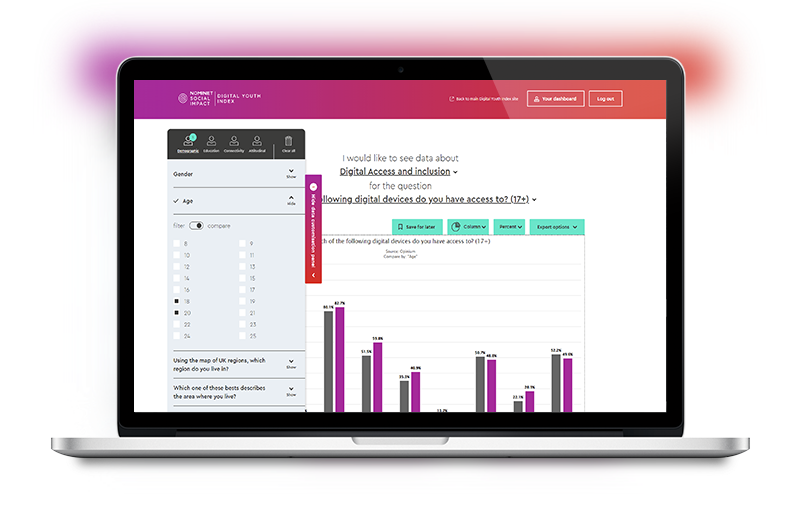It’s hard to imagine life without some sort of interaction with technology and the digital world – from entertainment and leisure, in work and education, accessing information and services, to keeping in touch with friends and family. But digital inequalities have real consequences for being able to participate in life around you. This was thrown into the spotlight during the Covid pandemic with increased digital use – particularly for young people who had to suddenly shift to remote learning. Since then, the need to address digital inequality has rightly come into greater focus. Last year’s Nominet Digital Youth Index provided a very timely picture of young people’s access to and use of technology and the internet, as well as who is at risk of being left behind and what it means to be missing out. We are looking forward to seeing how things have changed in the second year of the Index.
There is an agreed need to improve digital inclusion, but it can be hard to pin down what this really means. What are people lacking if they are digitally excluded and what do people need to be included? As highlighted in the Nominet Digital Youth Index, answering such questions isn’t simple. In reality, people are seldom either digitally included or excluded in a binary way – there is much middle ground and there are multiple intersecting aspects to being engaged with technology and sustaining access to the digital world.
We are part of a team undertaking research to develop a benchmark for a ‘Minimum Digital Living Standard’ (MDLS) for households. As a starting point, in this proof-of-concept study we are looking at the needs of households with children – what they need to be able to access, have and do in order to feel able to fully participate in today’s digital world. We are drawing on our established Minimum Income Standard approach and its key principles of:
- looking at needs from the perspective of citizens themselves, through a series of discussion groups with members of the public to find out what is important to them in their everyday lives
- establishing a minimum acceptable level which is about more than the basics for survival to enable people to participate in society.
The project, which is funded by the Nuffield Foundation and Nominet, involves discussion groups with parents to discuss what they think parents and children of different ages need, and crucially includes groups with young people to hear directly their own perspectives and opinions about digital needs. The MDLS looks at the needs of individuals, but within the context of the family unit, to capture the complex mix of access, device types and skills needed within households. Including the perspective of young people, and what is important to them, allows us to establish how young people’s views may differ or reflect those of parents, carers or adults in their lives, or if they bring up things that adults just wouldn’t think of.
We are delighted to be working with Nominet on this youth engagement piece and hope that the MDLS will complement the Nominet Digital Youth Index through establishing what people say they need, in order to then compare this with what people actually have or do. A key aspect of both MDLS and the Digital Youth Index is the holistic approach to digital needs. In the initial stages of the research, participants helped to develop a definition of what the MDLS should look like which is now being used throughout the research:
‘A minimum digital standard of living includes, but is more than, having accessible internet, adequate equipment, and the skills, knowledge and support people need. It is about being able to communicate, connect and engage with opportunities safely and with confidence.’
It is striking how this definition reflects the five Digital Youth Index ‘pillars’- covering access, connectivity, digital skills, online safety, digital wellbeing. This highlights the importance of going beyond simply having a device or connection – people need both – and that these must go alongside having the skills and knowledge, to get online safely.
The process of developing the MDLS definition has touched on similar topics. Participants in the groups that developed the definition stressed that people need to understand and be able to minimise risks in relation to security, for example scams and crucially to avoid online harms. Children’s online safety is flagged as a primary concern, with parents describing this as a ‘scary’ aspect of the digital world and one that was hard to keep up with.
The MDLS research is asking groups of participants what skills and knowledge they think parents, carers and children need – from actual practical tasks in using devices, managing data or knowing how to use safety controls to understanding online risks and harms, how to navigate these as individuals and as a family and what support would be helpful. Young people have also raised issues around the pressures and impact of social media in relation to their wellbeing.
The MDLS definition also encompasses sufficiency – that people should have equipment and connection that is adequate to do what they need to do. The Nominet Digital Youth Index has highlighted the difficulties of having to use an old device or of poor internet connection. This is something we are exploring in MDLS by asking parents, carers and young people about what types of devices people need, what the required quantities of devices or sizes of data packages are and how often devices need replacing.
We are partway through the MDLS research with initial reporting due in Spring 2023. The Nominet Digital Youth Index 2021 has been valuable in informing the MDLS work, for example in highlighting variation in age groups as well as differences between the perspectives of young people, carers and parents. The second Nominet Digital Youth Index report launching next Monday will bring a vital longitudinal aspect given we know that technology changes at a fast pace. It will be interesting to follow changes that surface in the study, in light of topical realities such as how the current cost of living crisis is impacting on young people’s ability to meet their digital needs. We hope that alongside the Nominet Digital Youth Index, the MDLS will offer the ability to enhance insight and understanding, stimulate debate and deepen the evidence base to help enable people to participate and thrive in the digital world.
Register for the Nominet Digital Youth Index 2022 launch event.
Katherine Hill | Centre for Research in Social Policy | Loughborough University (lboro.ac.uk)
Katherine’s research has focussed predominantly on qualitative projects in the area of social security policy, disadvantaged groups and low income with a particular interest in the perspectives of people themselves. Katherine’s more recent work has drawn on Minimum Income Standards (MIS) research to look at the additional needs and costs that some people face, and the experiences of those whose income falls below the MIS level. Katherine is part of the team using the MIS methodology to develop a Minimum Digital Living Standard for families with children.
Chloe Blackwell | Centre for Research in Social Policy | Loughborough University (lboro.ac.uk)
Chloe joined the Centre for Research in Social Policy at Loughborough University in 2018 as a PhD student. Chloe contributed to the research centre’s Minimum Income Standard (MIS) research before joining the Centre as a full-time research associate. Recently, Chloe has been involved in a project which draws upon the MIS methodology to explore a Minimum Digital Living Standard.
Share this article







